The seven military classics of ancient China are a group of influential military treatises were written during the Eastern Han dynasty (25-220 AD) and the Three Kingdoms period (220-280 AD). These texts were considered essential reading for military leaders and strategists in ancient China, and they continue to be studied and analyzed for their insights on military theory, strategy, and tactics. The seven military classics are:
- “The Art of War” by Sun Tzu: Perhaps the most well-known and influential of the military classics. It is a manual on military strategy and tactics that emphasizes the importance of deception and flexibility in warfare.
- “The Strategies of the Warring States” by Sun Bin: This text is attributed to Sun Bin, a military strategist and descendant of Sun Tzu. It is a compilation of strategies and tactics used by the various states during the Warring States period (475-221 BC).
- “The Methods of the Sima” by Sima Rangju: This text is attributed to Sima Rangju, a military strategist and adviser to the Han dynasty. It is a manual on military organization and tactics.
- “The Six Secret Teachings” by Jia Yi: This text is attributed to Jia Yi, a Han dynasty poet and official. It is a manual on military strategy that emphasizes the importance of mobility and the use of spies.
- “Wuzazu” by Wu Qi: This text is attributed to Wu Qi, a military strategist and general during the Warring States period. It is a manual on military strategy and tactics that emphasizes the importance of logistics and the use of chariots in warfare.
- “The Wujing Zongyao” by Zeng Gongliang: This text is a compendium of military technology, including descriptions of weapons, fortifications, and other military equipment.
- “The Huolongjing” by Jiao Yu: This text is a manual on the use of fire in warfare, including descriptions of incendiary weapons and the construction of flame-throwers.
These texts cover a wide range of topics, including military strategy and tactics, logistics, the use of spies, and the development and use of military technology. They are considered some of the most important works on military theory and practice in ancient China, and they continue to be studied and analyzed to this day.
1: THE ART OF WAR:
“The Art of War” by Sun Tzu, despite being written around 2,500 years ago, remains highly relevant in the context of modern Great Power Competition (GPC) and gray war. This ancient text offers timeless strategic principles that transcend specific historical periods and technological advancements. Below are several ways in which Sun Tzu’s wisdom continues to be applicable:
- The Importance of Strategy Over Force: Sun Tzu emphasizes that the acme of skill is to subdue the enemy without fighting. This principle is particularly relevant in gray war, where direct military engagement is often avoided in favor of indirect methods such as cyber attacks, economic pressure, disinformation campaigns, and diplomatic maneuvering.
- Understanding and Exploiting Weaknesses: Sun Tzu advises knowing both oneself and the enemy to ensure victory. In the age of GPC and gray war, understanding the weaknesses and vulnerabilities of adversaries — be it in their economy, political system, social cohesion, or cyber infrastructure — can be key to gaining an advantage without resorting to open conflict.
- The Element of Deception: “All warfare is based on deception,” according to Sun Tzu. In the digital age, this principle is manifest in cyber warfare, psychological operations, and the strategic use of misinformation to mislead or manipulate opponents and public opinion.
- Flexibility and Adaptability: Sun Tzu highlights the importance of being as fluid as water in adapting to the terrain and the enemy’s movements. In today’s rapidly changing geopolitical landscape, flexibility and the ability to quickly adjust to new developments are critical for maintaining strategic advantage.
- Economy of Force: Sun Tzu suggests that one should not overextend but rather concentrate strength to exploit the enemy’s weaknesses. In modern terms, this can apply to judiciously applying economic sanctions, targeted cyber operations, or diplomatic pressure rather than committing extensive resources to uncertain or large-scale military engagements.
- Strategic Use of Spies: Intelligence gathering and espionage play a crucial role in Sun Tzu’s strategies. In the modern era, intelligence—ranging from electronic surveillance to human intelligence and cyber espionage—is central to understanding adversaries’ intentions and capabilities in GPC and gray conflicts.
- Moral Influence and Leadership: Sun Tzu discusses the importance of moral influence and effective leadership in securing the loyalty and morale of one’s forces. In contemporary terms, this extends to the importance of soft power, the legitimacy of government actions, and the ability to inspire and lead not only a nation’s military but also its population and allies.
In essence, “The Art of War” provides strategic concepts that are applicable to the multifaceted and often indirect nature of modern global competition and conflicts. Its emphasis on strategy, intelligence, psychological factors, and efficient use of resources aligns closely with the methods employed in GPC and gray war scenarios.
2: THE STRATEGIES OF WARRING STATES
“The Strategies of the Warring States” (also known as “Zhan Guo Ce”) is a collection of historical records, anecdotes, and strategic advice from the Warring States period of Chinese history (475-221 BC). Despite its ancient origins, this work remains relevant in the context of modern great power competition and gray war. Here are a few reasons why “The Strategies of the Warring States” continues to offer valuable insights:
- Emphasis on Strategic Flexibility: The text showcases various strategies employed by the states to navigate the complex and ever-changing geopolitical landscape of the time. This idea of adapting to changing circumstances and leveraging opportunities is crucial in today’s world where power dynamics and alliances can shift rapidly.
- Use of Non-Military Means: Many of the strategies discussed involve non-military means of gaining advantage, such as diplomacy, espionage, economic measures, and psychological warfare. These approaches are highly relevant to gray war, where direct military confrontation is often avoided in favor of subtler forms of conflict.
- Understanding of Human Nature and Leadership: The anecdotes and strategies often delve into psychological insights regarding leadership, motivation, and human behavior. In the realm of modern international relations and gray war, understanding and influencing the behavior of leaders, governments, and populations remain critical.
- Importance of Intelligence and Information: The collection underscores the value of espionage, information gathering, and deception. In today’s digital age, where information warfare and cyber operations play significant roles in great power competition, these ancient lessons on the strategic use of information are particularly pertinent.
- Insights into Alliance Building: The Warring States period was marked by shifting alliances and balance-of-power politics. The text provides examples of how states negotiated alliances and managed relationships with both allies and adversaries, offering lessons for contemporary diplomacy and coalition-building.
- Holistic View of Statecraft: “The Strategies of the Warring States” presents a holistic view of statecraft that integrates military, political, economic, and cultural elements. This comprehensive approach is essential in addressing the multifaceted challenges of modern great power competition and gray war.
In conclusion, while the specific historical context and technologies have changed, the fundamental principles of strategy, human psychology, and statecraft explored in “The Strategies of the Warring States” continue to offer valuable insights for understanding and navigating the complexities of modern international relations and conflict.
3: THE METHODS OF THE SIMA
“The Methods of the Sima” (also known as “Sima Fa”) is one of the lesser-known military classics of ancient China, attributed to Sima Rangju, a military figure from the early Warring States period. Despite its lower profile compared to Sun Tzu’s “The Art of War,” “The Methods of the Sima” contains valuable insights that remain relevant in the context of Great Power Competition (GPC) and gray war. Here’s how:
- Focus on Logistics and Preparation: “The Methods of the Sima” emphasizes the importance of logistical preparation and support for military operations. In modern GPC and gray war scenarios, logistics extend beyond mere supply chains to include information infrastructure, cyber capabilities, and economic resilience. Effective preparation in these areas is critical for sustaining long-term strategic competition.
- Comprehensive National Defense: The text advocates for a holistic approach to defense, integrating military, civilian, and governmental elements. This is especially pertinent today, where threats are not only military but also economic, cyber, and informational. A comprehensive national defense strategy that involves all sectors of society can enhance resilience against such multifaceted threats.
- Adaptation to Terrain and Circumstances: Sima Rangju stressed the importance of adapting military tactics to the terrain and the specific circumstances of the conflict. In the modern era, this principle translates to the need for adaptability in the face of changing technological landscapes and geopolitical conditions. Adapting strategies to leverage the digital terrain, for instance, is crucial in cyber warfare and information operations.
- Intelligence and Counterintelligence: The importance of espionage and counterespionage operations is highlighted, with a focus on the strategic use of intelligence to outmaneuver opponents. In today’s GPC and gray war contexts, intelligence operations extend to cyberspace, where securing information and protecting against leaks are vital for maintaining a strategic edge.
- Strategic Timing: The text underscores the importance of timing in military operations. In the contemporary strategic environment, timing can be critical in diplomatic maneuvers, economic sanctions, cyber operations, and other non-kinetic forms of engagement, where the right action at the right time can have significant strategic impacts.
- Moral and Psychological Aspects of Warfare: “The Methods of the Sima” also touches upon the moral and psychological dimensions of warfare, recognizing the importance of morale, leadership, and the psychological state of both the military and the civilian population. In modern conflict scenarios, the morale and cohesion of societies, as well as the strategic narrative and information warfare, play critical roles in sustaining long-term competitive efforts.
- The Element of Surprise: Like Sun Tzu, Sima Rangju also emphasizes the value of surprise in military strategy. In the current age, achieving surprise can often mean innovating in technology, tactics, and strategy, particularly in domains like cyber warfare, space, and emerging technologies, where unexpected advancements or applications can significantly alter the strategic balance.
“The Methods of the Sima,” with its emphasis on logistics, comprehensive defense, adaptability, intelligence, timing, psychological factors, and surprise, provides a framework that is highly applicable to the strategic considerations of modern GPC and gray warfare, where conflicts extend beyond conventional battlefields and involve a wide array of state and non-state actors.
4: THE SIX SECRET TEACHINGS
“The Six Secret Teachings” (六韜, Liutao) is often attributed to Jiang Ziya (also known as Taigong), a legendary military strategist and a key figure in the founding of the Zhou Dynasty. This classic text is a comprehensive treatise on statecraft, military strategy, and leadership, organized into six sections, each dealing with different aspects of military affairs and governance.
Despite its ancient origins, “The Six Secret Teachings” holds relevance in the contemporary era of Great Power Competition (GPC) and gray war for several reasons:
- Civil-Military Fusion: The text emphasizes the integration of civilian governance and military strategy, advocating for a harmonious relationship between the ruler, the state, and the military. In modern times, this concept aligns with the notion of a whole-of-government approach to national security, where economic, diplomatic, informational, and military tools are synchronized to achieve strategic objectives.
- Leadership and Governance: “The Six Secret Teachings” offers insights into effective leadership and the management of state affairs, including the selection and management of personnel, and the importance of moral authority. In the context of GPC, leadership qualities and governance structures are crucial in maintaining domestic stability, securing public support, and effectively implementing long-term strategic initiatives.
- Psychological and Information Warfare: The teachings delve into the psychological aspects of warfare, including the use of deception, persuasion, and morale-building measures. These principles are directly applicable to modern information operations, strategic communication, and influence campaigns that are integral components of gray war tactics, where shaping perceptions and narratives can be as important as physical dominance.
- Adaptability and Opportunism: The text advises on being adaptable to changing circumstances and leveraging opportunities. In the fluid and dynamic environment of GPC, where technological advancements and geopolitical shifts occur rapidly, the ability to quickly adapt and capitalize on emerging opportunities is a significant strategic advantage.
- Espionage and Intelligence: “The Six Secret Teachings” also discusses the importance of espionage and the strategic use of spies. In the digital age, intelligence gathering, cyber espionage, and counterintelligence operations play critical roles in understanding adversaries’ intentions, capabilities, and vulnerabilities, thus informing strategic decisions in GPC and gray war scenarios.
- Strategic Patience and Long-term Planning: The teachings advocate for strategic patience and careful long-term planning, emphasizing that success may require waiting for the right moment to act. This approach is particularly relevant in GPC, where strategic patience and sustained efforts are often necessary to achieve long-term goals in the face of complex and protracted competition.
- Hybrid Strategies: The text’s holistic approach to warfare, which blends conventional military strategies with unconventional tactics, mirrors modern hybrid warfare strategies where a wide range of military and non-military tools are employed to achieve strategic objectives.
In summary, “The Six Secret Teachings” offers timeless wisdom on leadership, statecraft, psychological warfare, intelligence, and the integration of military and civilian efforts. These principles are highly applicable to the strategic challenges of the 21st century, particularly in the realms of GPC and gray war, where multifaceted and nuanced approaches are essential for navigating the complexities of international relations and conflict.
5: WUZAZU
“Wuzazu” (also known as “Wu Zi”) is a classic military treatise attributed to Wu Qi, an ancient Chinese military strategist and statesman. Wu Qi was known for his contributions to military reforms and strategies during the Warring States period. The relevance of “Wuzazu” in the context of modern Great Power Competition (GPC) and gray war includes several key aspects:
- Comprehensive Statecraft and Military Reform: Wu Qi emphasized the importance of integrating military strategy with state governance, advocating for reforms that strengthened the state and its military capabilities. In the age of GPC, the alignment of national strategy, economic strength, and military power is crucial for maintaining competitiveness and security in a multipolar world.
- People-Centric Warfare: Wu Qi believed in the importance of winning the hearts and minds of both the civilian population and the military. In contemporary conflicts, especially in gray war scenarios, the battle for influence and legitimacy often plays out in the public domain, with information warfare and psychological operations targeting both domestic and international audiences.
- Discipline and Training: The treatise underscores the importance of strict discipline and rigorous training for soldiers. In modern militaries, this principle extends beyond physical training to include advanced technological and possibly current day cyber warfare skills, critical for maintaining an edge in increasingly sophisticated and high-tech conflict environments.
- Use of Spies and Intelligence: Wu Qi highlighted the strategic use of espionage to gather critical information about the enemy. Intelligence operations remain a cornerstone of modern military strategy, particularly in the context of GPC, where understanding the intentions, capabilities, and actions of competitors is vital for strategic planning and decision-making.
- Adaptability and Innovation: Wu Qi’s strategies involved adaptability and innovative tactics to overcome adversaries. This mirrors the current need for innovation in military doctrine, technology, and tactics to address the evolving challenges of hybrid warfare, cyber threats, and other non-traditional security challenges.
- Logistics and Resource Management: “Wuzazu” also discusses the importance of logistics and efficient resource management for sustaining military campaigns. In today’s extended theaters of competition, which can span global supply chains, cyberspace, and outer space, effective logistics and resource allocation are critical for maintaining operational readiness and strategic flexibility.
- Moral and Ethical Warfare: Wu Qi was known for advocating humane treatment of soldiers and civilians, reflecting an understanding of the moral dimensions of warfare. In the age of GPC and gray war, adherence to international norms, ethical conduct, and the law of armed conflict not only maintains moral high ground but also plays a significant role in international legitimacy and soft power.
“Wuzazu” provides timeless insights into military strategy, statecraft, and the moral considerations of warfare, all of which remain relevant in the complex landscape of modern geopolitical competition and conflict. The treatise’s emphasis on integrating military and civil governance, along with its focus on discipline, intelligence, logistics, and ethical conduct, offers valuable lessons for contemporary military and political leaders navigating the intricacies of GPC and gray war.
6: THE WUJING ZONGYAO
“The Wujing Zongyao” (武经总要), often translated as “Collection of the Most Important Military Techniques,” is a Chinese military compendium written in 1044 during the Song Dynasty by Zeng Gongliang, Ding Du, and others. This work is notable for being one of the earliest known texts to describe the use of gunpowder weapons, among other military technologies and strategies. Despite its ancient context, “The Wujing Zongyao” holds relevance in the contemporary era of Great Power Competition (GPC) and gray war for several reasons:
- Innovation and Military Technology: “The Wujing Zongyao” documents the innovative military technologies of its time, including the use of gunpowder. In the modern context, continuous innovation in military technology is crucial for maintaining a competitive edge in GPC, with advancements in cyber warfare, artificial intelligence, unmanned systems, and space capabilities shaping the future battlefield.
- Comprehensive Approach to Warfare: The compendium covers a wide range of military topics, from weapons and equipment to formations and strategies. This holistic approach underscores the importance of integrating various elements of military power in contemporary strategies, where multi-domain operations involving land, sea, air, space, and cyber domains are critical for success in GPC and gray war scenarios.
- Importance of Logistics and Support Systems: The text also details logistical aspects, such as the manufacturing of weapons and the preparation of military supplies. Effective logistics and support systems remain fundamental in modern military operations, ensuring that forces are well-equipped, supplied, and capable of sustaining prolonged engagements in diverse and challenging environments.
- Historical Insight and Learning from the Past: Studying historical military texts like “The Wujing Zongyao” provides valuable insights into the evolution of military thought and technology. Understanding historical innovations and strategies can inspire modern military thinkers and practitioners to develop new concepts and approaches to address contemporary security challenges.
- Cultural and Psychological Aspects of Warfare: While “The Wujing Zongyao” is primarily a technical manual, the context in which it was written reflects the cultural and psychological dimensions of warfare in the Song Dynasty. Similarly, in the age of GPC and gray war, cultural understanding, psychological operations, and information warfare play significant roles in shaping perceptions, influencing populations, and achieving strategic objectives without resorting to open conflict.
- Defensive Strategies: The Song Dynasty, during which “The Wujing Zongyao” was written, faced significant external threats. The focus on defensive technologies and strategies in the compendium is relevant for modern states seeking to enhance their defensive capabilities against both conventional and unconventional threats in a complex international security environment.
In conclusion, “The Wujing Zongyao” remains relevant in the modern era by providing insights into military innovation, the integration of technology and strategy, the importance of logistics, and the value of historical knowledge in informing contemporary military thought and practice. Its contributions to the understanding of ancient military technologies and strategies enrich the ongoing discourse on security, defense, and strategic competition in the 21st century.
7: THE HUOLONGJING
“The Huolongjing” (火龍經), also known as the “Fire Dragon Manual,” is a comprehensive Chinese military treatise compiled and edited by Jiao Yu and Liu Ji during the late Yuan and early Ming periods. The text is renowned for its detailed descriptions of gunpowder weapons, including early forms of cannons, bombs, and even rockets. Despite being centuries old, “The Huolongjing” remains relevant in the modern era of GPC and gray war due to several enduring principles and themes:
- Innovation in Military Technology: “The Huolongjing” exemplifies the spirit of innovation, particularly in the use of gunpowder, which revolutionized warfare. Today, continuous technological innovation remains critical in GPC, with advancements in areas such as cyber capabilities, artificial intelligence, drones, and hypersonic weapons shaping the strategic landscape.
- Asymmetrical Warfare: The gunpowder weapons described in “The Huolongjing” provided means to challenge and defeat more conventionally powerful foes, illustrating the concept of asymmetrical warfare. In contemporary conflicts, smaller or less conventionally powerful actors use asymmetrical strategies, including cyber attacks, guerrilla tactics, and disinformation campaigns, to exploit vulnerabilities of more powerful states.
- Psychological Impact of Weapons: The psychological effect of gunpowder weapons on adversaries who had never encountered them before was significant. Similarly, modern weapons and tactics, especially those with high shock value or those used in information warfare, aim to demoralize opponents, sway public opinion, and achieve strategic objectives without full-scale conflict.
- Importance of Defense and Countermeasures: Just as “The Huolongjing” discussed the use of gunpowder in sieges and defensive fortifications, modern military strategy emphasizes the development of defenses against emerging threats, such as missile defense systems, cybersecurity measures, and counter-drone technologies, to protect against asymmetrical and high-tech attacks.
- Integration of Old and New Tactics: “The Huolongjing” integrates traditional military strategies with the innovative use of gunpowder, reflecting the importance of blending conventional and unconventional tactics. Modern military doctrines also advocate for a combined approach, integrating cyber operations, electronic warfare, and traditional kinetic capabilities to achieve multi-domain dominance.
- Logistics and Supply Chain: The production and deployment of gunpowder weapons required a well-organized logistical and supply chain, a principle that remains vital in contemporary warfare, where the complexity and global nature of supply chains for advanced technologies present both opportunities and vulnerabilities.
- Ethical and Legal Considerations: The destructive power of gunpowder weapons raised ethical and legal questions even in ancient times. Today, the development and use of advanced military technologies, including autonomous weapons and cyber warfare capabilities, similarly pose significant ethical, legal, and normative challenges that states and the international community must address.
In essence, “The Huolongjing” is relevant to the age of GPC and gray war not only as a historical document showcasing the innovative application of gunpowder in warfare but also as a reminder of the enduring principles of military strategy, including the importance of technological innovation, asymmetrical tactics, psychological warfare, and the integration of new technologies with traditional strategies. These themes continue to resonate in the complex and technologically driven landscape of 21st-century geopolitical competition and conflict.
TAKE AWAYS/COMMON THEMES
The Seven Military Classics of ancient China, despite their diverse authors and historical contexts, share several core themes and principles that have cemented their status as timeless works on strategy and statecraft. Common threads that run through these classics include:
- The Primacy of Strategy: Across all seven works, there is a consistent emphasis on the importance of strategic planning and forethought over reliance on brute force. The idea that winning a battle or a war is as much about out-thinking your opponent as it is about out-fighting them is a central tenet. Sun Tzu’s “The Art of War,” for instance, famously states, “The supreme art of war is to subdue the enemy without fighting.”
- The Importance of Intelligence and Espionage: The collection repeatedly underscores the value of intelligence gathering and espionage. Understanding the enemy’s intentions, capabilities, and movements is deemed essential for victory. This is encapsulated in Sun Tzu’s advice to “know your enemy and know yourself.”
- Flexibility and Adaptability: The classics advocate for flexibility and adaptability in tactics and strategies. Leaders are encouraged to be as fluid and adaptable as water, shaping their actions according to the situation at hand rather than adhering rigidly to preconceived plans.
- Moral Influence and Leadership: Moral influence, including the ability to win the hearts and minds of both one’s own people and the enemy, is highlighted as a crucial element of effective leadership. This includes maintaining high moral standards, providing clear and inspiring leadership, and ensuring the well-being of the troops.
- The Economy of Warfare: The texts often discuss the costs of warfare, not just in human terms but also in terms of resources. There is a clear understanding that protracted warfare can drain a state’s resources and weaken it, thus the idea of winning swiftly and efficiently is advocated.
- The Integration of Civil and Military Affairs: Several of the classics emphasize the interconnection between civil governance and military strategy. The strength of a state’s military is seen as inseparable from the quality of its governance, economic policies, and social cohesion.
- The Use of Deception and Psychological Warfare: The strategic use of deception, psychological tactics, and indirect methods to undermine the enemy’s will and capability to fight is a recurring theme. This includes the use of feints, misinformation, and other means to confuse and demoralize the opponent.
- Harmony with the Environment: There is a recognition of the importance of understanding and working with the natural environment, including geography and climate, in military planning and operations. The texts often advise leaders to take into consideration the terrain, seasons, and other natural factors in their strategies.
- Ethical Considerations in Warfare: While not uniform across all texts, there are discussions on the ethics of warfare, including the treatment of prisoners, non-combatants, and the use of force. These considerations reflect an understanding of the broader impacts of warfare on society and the moral responsibilities of those who wage it.
These common threads illustrate the holistic approach to warfare and statecraft espoused by the Seven Military Classics. They encompass not just tactics and battlefield maneuvers, but also strategic planning, leadership, governance, and ethical considerations, offering a comprehensive framework for understanding and engaging in complex political and military landscapes.










